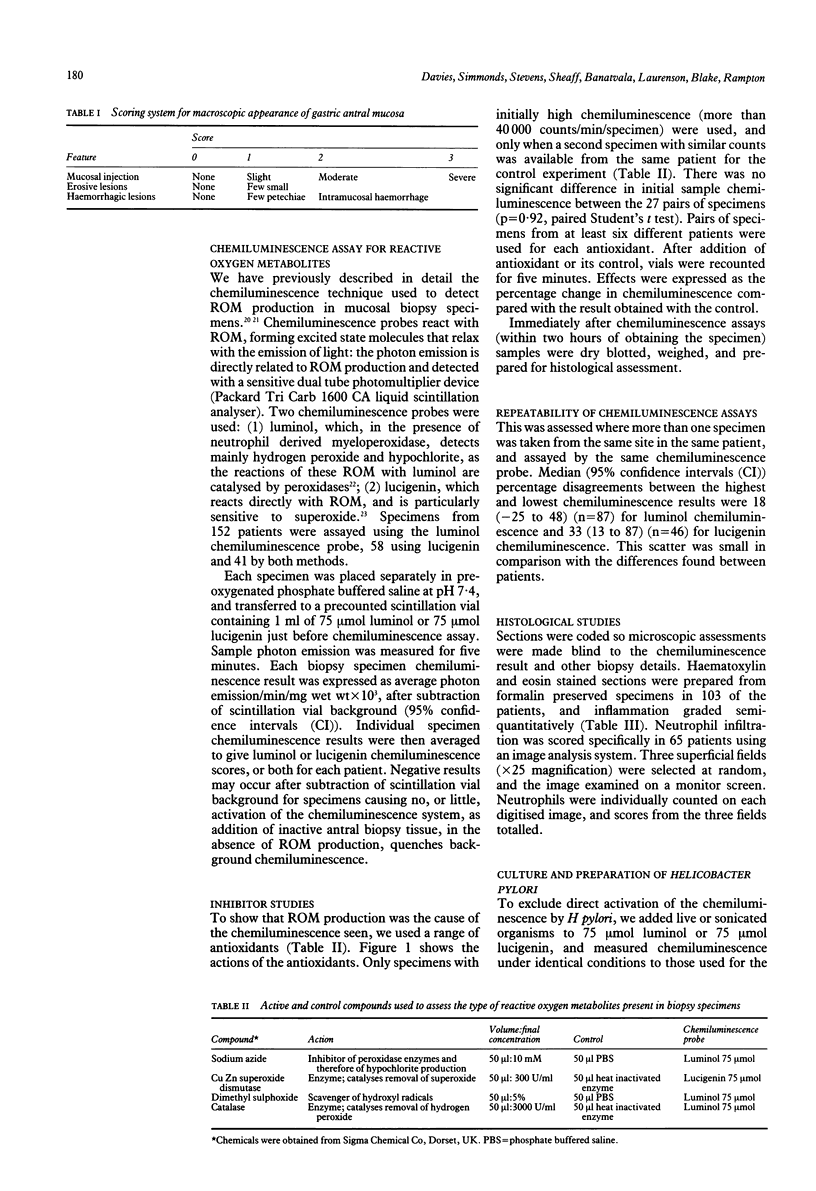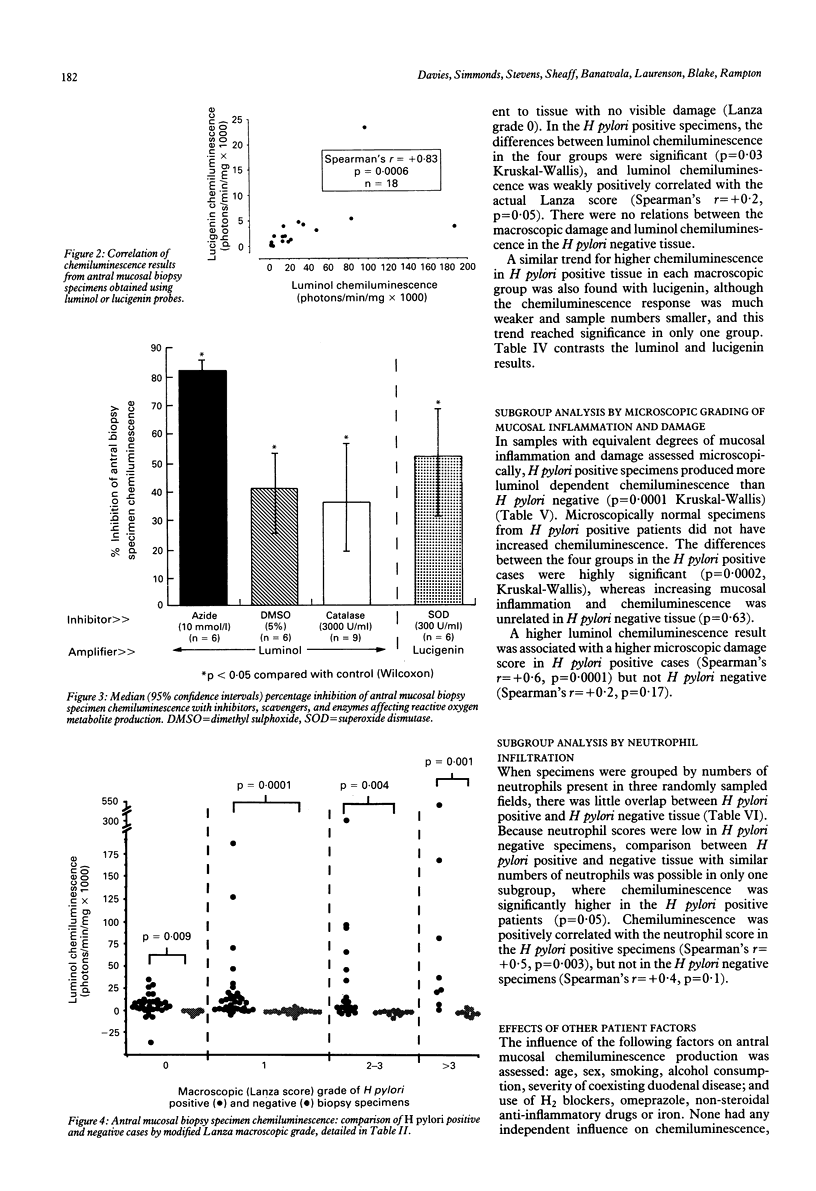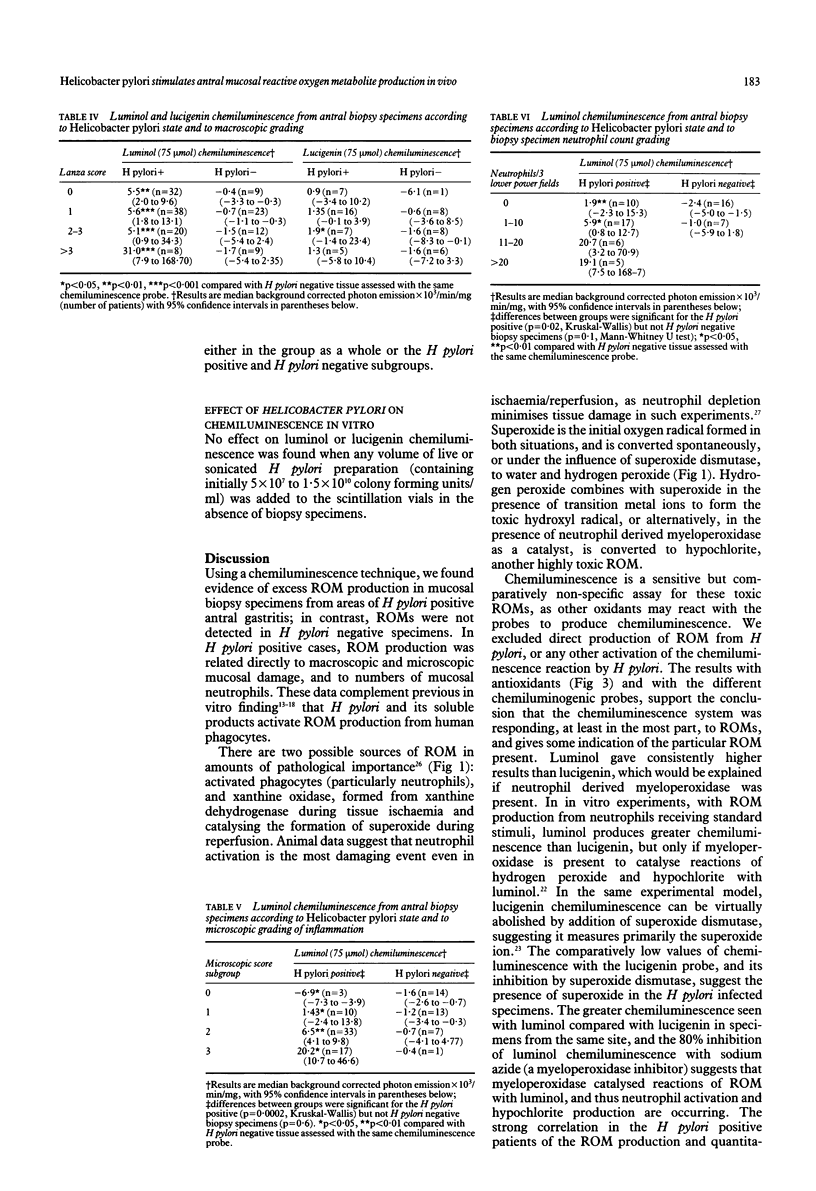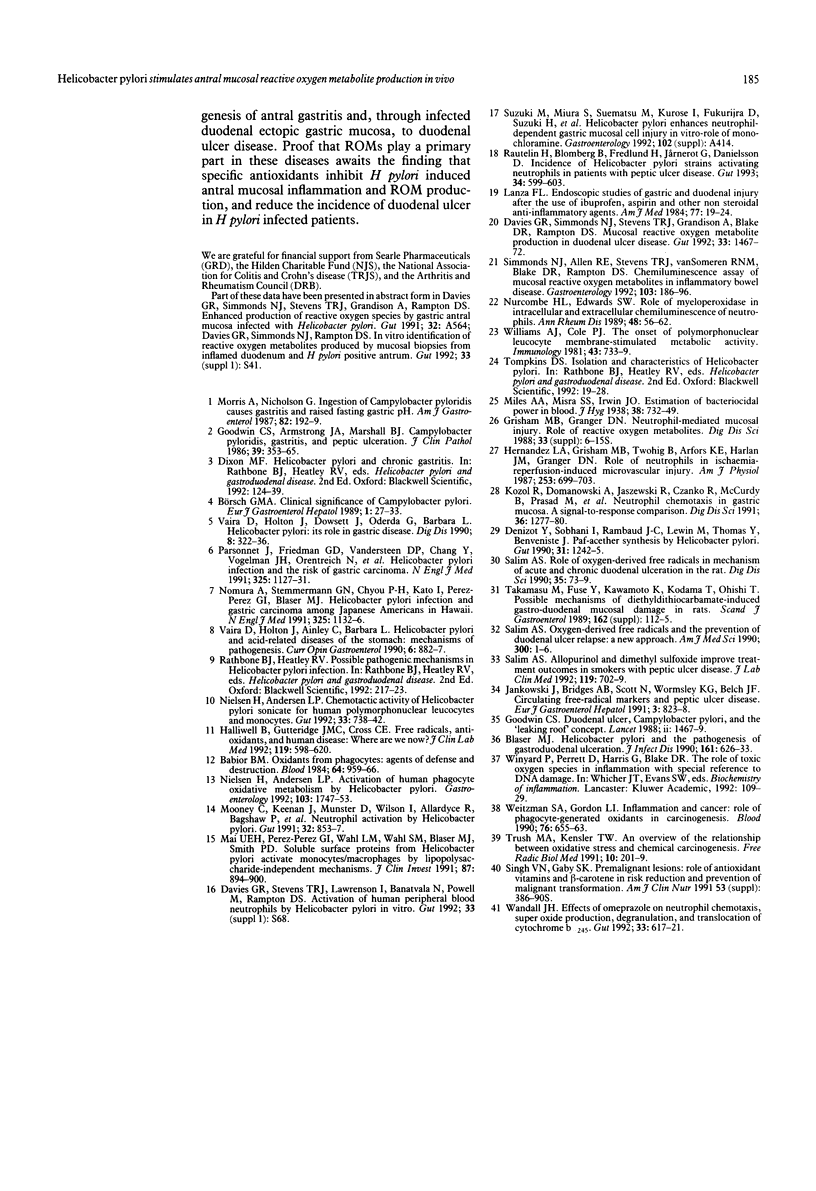Abstract
To determine if reactive oxygen metabolites have a pathogenic role in Helicobacter pylori (H pylori) related gastroduodenal disease, this study measured their production in antral mucosal biopsy specimens. Two related chemiluminescence techniques were used comparing H pylori positive (n = 105) and negative patients (n = 64) with a similar spectrum of macroscopic disease. After chemiluminescence assays, biopsy specimens were graded histologically. Increased luminol dependent chemiluminescence (detecting reactive oxygen metabolites through peroxidase catalysed reactions) was found in H pylori positive patients (median photon emission = 6.4 x 10(3)/min/mg wet weight (95% confidence intervals 3.6 to 9.9)) but not H pylori negative cases (-0.9 (-1.3 to -0.6)) (p = 0.0001). Similar results were found using lucigenin (which reacts directly with oxygen metabolites, particularly superoxide): (H pylori positive 0.9 (0.1 to 3.2); H pylori negative -1.2 (-3.4 to -0.6)) (p = 0.0003). Chemiluminescence was greater in H pylori positive compared with negative tissue when samples were grouped by equivalent macroscopic or microscopic damage. This difference was in part accounted for by a greater neutrophil infiltration in the H pylori positive mucosa, but when biopsy specimens with equivalent neutrophil infiltration could be compared directly, positive specimens gave greater chemiluminescence than negative. Smoking, drugs, and alcohol consumption had no independent effect. It is concluded that excess mucosal reactive oxygen metabolite production is associated with H pylori gastric antral infection and may be an important pathogenic mechanism. There is no evidence for reactive oxygen metabolite participation in the pathogenesis of gastric mucosal injury in cases unrelated to H pylori infection.
Full text
PDF






Selected References
These references are in PubMed. This may not be the complete list of references from this article.
- Babior B. M. Oxidants from phagocytes: agents of defense and destruction. Blood. 1984 Nov;64(5):959–966. [PubMed] [Google Scholar]
- Blaser M. J. Helicobacter pylori and the pathogenesis of gastroduodenal inflammation. J Infect Dis. 1990 Apr;161(4):626–633. doi: 10.1093/infdis/161.4.626. [DOI] [PubMed] [Google Scholar]
- Davies G. R., Simmonds N. J., Stevens T. R., Grandison A., Blake D. R., Rampton D. S. Mucosal reactive oxygen metabolite production in duodenal ulcer disease. Gut. 1992 Nov;33(11):1467–1472. doi: 10.1136/gut.33.11.1467. [DOI] [PMC free article] [PubMed] [Google Scholar]
- Denizot Y., Sobhani I., Rambaud J. C., Lewin M., Thomas Y., Benveniste J. Paf-acether synthesis by Helicobacter pylori. Gut. 1990 Nov;31(11):1242–1245. doi: 10.1136/gut.31.11.1242. [DOI] [PMC free article] [PubMed] [Google Scholar]
- Goodwin C. S., Armstrong J. A., Marshall B. J. Campylobacter pyloridis, gastritis, and peptic ulceration. J Clin Pathol. 1986 Apr;39(4):353–365. doi: 10.1136/jcp.39.4.353. [DOI] [PMC free article] [PubMed] [Google Scholar]
- Goodwin C. S. Duodenal ulcer, Campylobacter pylori, and the "leaking roof" concept. Lancet. 1988 Dec 24;2(8626-8627):1467–1469. doi: 10.1016/s0140-6736(88)90942-7. [DOI] [PubMed] [Google Scholar]
- Halliwell B., Gutteridge J. M., Cross C. E. Free radicals, antioxidants, and human disease: where are we now? J Lab Clin Med. 1992 Jun;119(6):598–620. [PubMed] [Google Scholar]
- Kozol R., Domanowski A., Jaszewski R., Czanko R., McCurdy B., Prasad M., Fromm B., Calzada R. Neutrophil chemotaxis in gastric mucosa. A signal-to-response comparison. Dig Dis Sci. 1991 Sep;36(9):1277–1280. doi: 10.1007/BF01307522. [DOI] [PubMed] [Google Scholar]
- Lanza F. L. Endoscopic studies of gastric and duodenal injury after the use of ibuprofen, aspirin, and other nonsteroidal anti-inflammatory agents. Am J Med. 1984 Jul 13;77(1A):19–24. doi: 10.1016/s0002-9343(84)80014-5. [DOI] [PubMed] [Google Scholar]
- Mai U. E., Perez-Perez G. I., Wahl L. M., Wahl S. M., Blaser M. J., Smith P. D. Soluble surface proteins from Helicobacter pylori activate monocytes/macrophages by lipopolysaccharide-independent mechanism. J Clin Invest. 1991 Mar;87(3):894–900. doi: 10.1172/JCI115095. [DOI] [PMC free article] [PubMed] [Google Scholar]
- Mooney C., Keenan J., Munster D., Wilson I., Allardyce R., Bagshaw P., Chapman B., Chadwick V. Neutrophil activation by Helicobacter pylori. Gut. 1991 Aug;32(8):853–857. doi: 10.1136/gut.32.8.853. [DOI] [PMC free article] [PubMed] [Google Scholar]
- Morris A., Nicholson G. Ingestion of Campylobacter pyloridis causes gastritis and raised fasting gastric pH. Am J Gastroenterol. 1987 Mar;82(3):192–199. [PubMed] [Google Scholar]
- Nielsen H., Andersen L. P. Activation of human phagocyte oxidative metabolism by Helicobacter pylori. Gastroenterology. 1992 Dec;103(6):1747–1753. doi: 10.1016/0016-5085(92)91430-c. [DOI] [PubMed] [Google Scholar]
- Nielsen H., Andersen L. P. Chemotactic activity of Helicobacter pylori sonicate for human polymorphonuclear leucocytes and monocytes. Gut. 1992 Jun;33(6):738–742. doi: 10.1136/gut.33.6.738. [DOI] [PMC free article] [PubMed] [Google Scholar]
- Nomura A., Stemmermann G. N., Chyou P. H., Kato I., Perez-Perez G. I., Blaser M. J. Helicobacter pylori infection and gastric carcinoma among Japanese Americans in Hawaii. N Engl J Med. 1991 Oct 17;325(16):1132–1136. doi: 10.1056/NEJM199110173251604. [DOI] [PubMed] [Google Scholar]
- Nurcombe H. L., Edwards S. W. Role of myeloperoxidase in intracellular and extracellular chemiluminescence of neutrophils. Ann Rheum Dis. 1989 Jan;48(1):56–62. doi: 10.1136/ard.48.1.56. [DOI] [PMC free article] [PubMed] [Google Scholar]
- Parsonnet J., Friedman G. D., Vandersteen D. P., Chang Y., Vogelman J. H., Orentreich N., Sibley R. K. Helicobacter pylori infection and the risk of gastric carcinoma. N Engl J Med. 1991 Oct 17;325(16):1127–1131. doi: 10.1056/NEJM199110173251603. [DOI] [PubMed] [Google Scholar]
- Rautelin H., Blomberg B., Fredlund H., Järnerot G., Danielsson D. Incidence of Helicobacter pylori strains activating neutrophils in patients with peptic ulcer disease. Gut. 1993 May;34(5):599–603. doi: 10.1136/gut.34.5.599. [DOI] [PMC free article] [PubMed] [Google Scholar]
- Salim A. S. Allopurinol and dimethyl sulfoxide improve treatment outcomes in smokers with peptic ulcer disease. J Lab Clin Med. 1992 Jun;119(6):702–709. [PubMed] [Google Scholar]
- Salim A. S. Role of oxygen-derived free radicals in mechanism of acute and chronic duodenal ulceration in the rat. Dig Dis Sci. 1990 Jan;35(1):73–79. doi: 10.1007/BF01537226. [DOI] [PubMed] [Google Scholar]
- Simmonds N. J., Allen R. E., Stevens T. R., Van Someren R. N., Blake D. R., Rampton D. S. Chemiluminescence assay of mucosal reactive oxygen metabolites in inflammatory bowel disease. Gastroenterology. 1992 Jul;103(1):186–196. doi: 10.1016/0016-5085(92)91112-h. [DOI] [PubMed] [Google Scholar]
- Takamasu M., Fuse Y., Kawamoto K., Kodama T., Ohishi T. Possible mechanisms of diethyldithiocarbamate-induced gastro-duodenal mucosal damage in rats. Scand J Gastroenterol Suppl. 1989;162:112–115. doi: 10.3109/00365528909091138. [DOI] [PubMed] [Google Scholar]
- Trush M. A., Kensler T. W. An overview of the relationship between oxidative stress and chemical carcinogenesis. Free Radic Biol Med. 1991;10(3-4):201–209. doi: 10.1016/0891-5849(91)90077-g. [DOI] [PubMed] [Google Scholar]
- Vaira D., Holton J., Dowsett J., Oderda G., Barbara L. Helicobacter pylori: its role in gastric disease. Dig Dis. 1990;8(6):322–336. doi: 10.1159/000171265. [DOI] [PubMed] [Google Scholar]
- Wandall J. H. Effects of omeprazole on neutrophil chemotaxis, super oxide production, degranulation, and translocation of cytochrome b-245. Gut. 1992 May;33(5):617–621. doi: 10.1136/gut.33.5.617. [DOI] [PMC free article] [PubMed] [Google Scholar]
- Weitzman S. A., Gordon L. I. Inflammation and cancer: role of phagocyte-generated oxidants in carcinogenesis. Blood. 1990 Aug 15;76(4):655–663. [PubMed] [Google Scholar]
- Williams A. J., Cole P. J. The onset of polymorphonuclear leucocyte membrane-stimulated metabolic activity. Immunology. 1981 Aug;43(4):733–739. [PMC free article] [PubMed] [Google Scholar]


